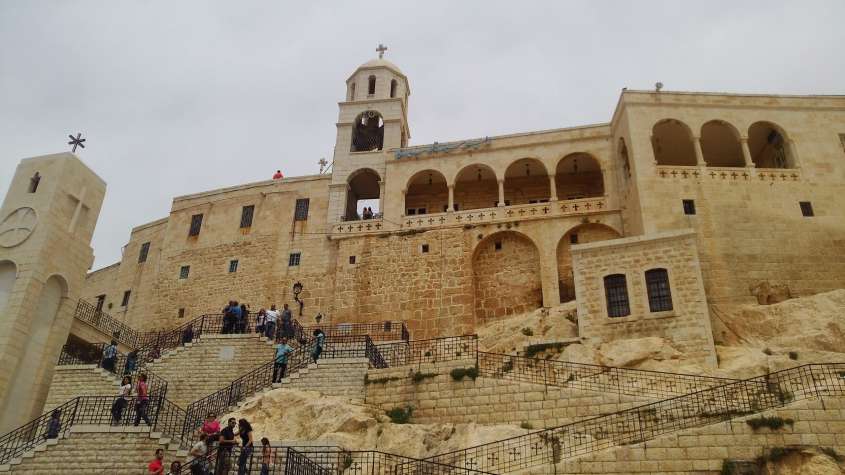Saidnaya: Where shackles meet sacred churches
DARAMSUQ, Syria — Under Syria’s former authoritarian regime, Saidnaya, a town in rural Daramsuq (Damascus), transformed from a vibrant hub of life to a place of death. Its name became synonymous with a notorious prison where political dissenters were tortured and killed.
A Name That Strikes Fear
Saidnaya evokes tales of unspeakable suffering among Syrians. The Syrian regime chose this small town to host one of its most infamous institutions: Saidnaya Military Prison. For decades, the mere mention of its name struck terror into the hearts of families across the country.
The prison, a fortress of cruelty, became the end of the line for thousands of political prisoners, whose only crime was opposing the regime—or sometimes, no crime at all. A fabricated report could seal a person’s fate, condemning them to vanish into the prison’s depths indefinitely.
The Land of Miracles
The small town of Saidnaya perched on the slopes of the Qalamoun Mountains, lies about 30 km northeast of Daramsuq (Damascus). Surrounded by the fertile plains of Daramsuq (Damascus) and the rugged peaks of Lebanon’s eastern mountains, it boasts an extraordinary concentration of religious and historical sites.
Before becoming synonymous with repression, Saidnaya was celebrated for its sacred landmarks. Historically known as the “Land of Miracles,” the town was famed for the Monastery of Our Lady of Saidnaya, often referred to as the “Great Church.” Saidnaya’s spiritual significance, recorded in texts and oral traditions, stood in stark contrast to the horrors that later unfolded in its prison.
Until the outbreak of armed conflict in 2011, Saidnaya welcomed over 2 million Christian pilgrims annually, its churches and monasteries offering solace and spiritual renewal.
An Ancient Past
The town has been inhabited since at least 6th century BCE, when it was known by its Aramaic name, Danaba. Archaeological findings, including caves and artifacts, reflect a history shaped by early Aramaic, Greek, Roman, and Christian civilizations. Over centuries, Catholic, Eastern Orthodox, Syriac Catholic, and Syriac Orthodox churches and monasteries were established, weaving a rich tapestry of faith.
The Iconic Monastery of Our Lady
Scholars agree that “Saidnaya” is Aramaic in origin, as are many place names in the Levant, such as “Daraya” and “Beit Lahia.” While interpretations differ, one theory suggests it means “Place of Hunting,” linked to the legend of Emperor Justinian and a miraculous gazelle that led him to build the Monastery of Our Lady.
Saidnaya’s most celebrated landmark is the Monastery of Our Lady, built in 547 CE by Byzantine Emperor Justinian. According to tradition, the Virgin Mary appeared to Justinian twice, guiding him to the location and design of the monastery. The *Shaghoura Icon,* housed within, is revered by pilgrims for its miraculous powers.
An Enduring Beacon of Faith
The monastery remains a vital institution of Eastern Orthodox monasticism, where nuns have lived and prayed without interruption since 5th century. It holds immense significance for Christians, second only to Jerusalem’s Church of the Holy Sepulchre.
Beyond the Monastery of Our Lady, Saidnaya is home to a remarkable array of churches and shrines. The Cherubim Monastery, perched 2,000 m above sea level, offers sweeping views of Daramsuq (Damascus) and Lebanon. The Monastery of Saint Thomas the Apostle and the Monastery of Saint George are each steeped in religious tradition. There is also the Church of Hagia Sophia, alongside lesser-known but equally revered sites like the Church of Saint Barbara, the Shrine of Saint Nicholas, and the Shrine of Saint Moses (*Maqam al-Qaddis Moussa*). Other notable sites include the Shrine of Saint Christopher, the Church of Transfiguration, and the Church of Saint Barbara.
A Testament to Faith
These religious structures, scattered across Saidnaya’s hills and valleys, highlight the town’s historical prominence among Christians in the East and West.
In a rare linguistic phenomenon, the residents of Saidnaya—both Muslims and Christians—continue to speak Aramaic, the language of Jesus Christ. This shared heritage connects them with neighboring towns like Maaloula, further underscoring Saidnaya’s unique cultural identity.
Today, Saidnaya stands as a paradox: a town burdened by the legacy of its infamous prison, yet uplifted by its sacred heritage. While the prison symbolizes repression and loss, the churches and monasteries remind the world of Saidnaya’s enduring spirit. Even in the darkest times, the town’s message of faith and love persists. Its sacred landmarks offer a beacon of hope, proving that resilience can thrive even amidst unimaginable suffering.

















